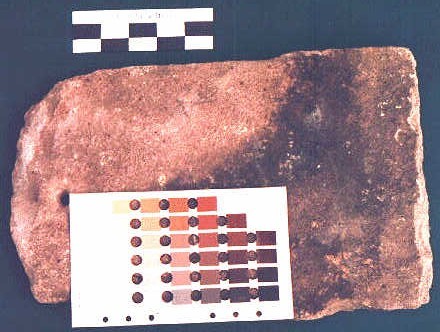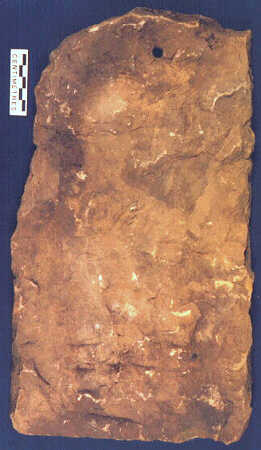| STONE ROOFING ASSOCIATION | |
| Home > Start > Contents > The appearance of stone slates |
| STONE ROOFING ASSOCIATION | |
| Home > Start > Contents > The appearance of stone slates |
| THE APPEARANCE OF STONE SLATES | ||||||||||||
| The appearance of new stone slates is influenced by grain size, colour, surface features and mineral composition. On the roof most of these can be modified by pollution or plant growth. Because the environments and processes of deposition of rocks varied over quite short distances and altered in time, their composition and structure can alter significantly even within a quarry. Therefore, it is quite possible that quarries would have produced tilestones which varied in these aspects from time to time. It follows that it may not be possible to predict the continued production, nor to insist on the supply, of products with particular characteristics except at the coarsest level of discrimination. | ||||||||||||
| GRAIN
SIZE
For hand specimens, grain size is expressed on the Wentworth scale where the following dimensions apply:
With practice (and a magnifying glass) these classes can be quite easily distinguished in the hand. |
||||||||||||
| COLOUR
Colour is a consequence of a range of factors and their effect on the stone's minerals. These include, the nature of the original sediment, the depositional and post-depositional environment and, following installation on the roof, weathering, pollution and plant growth. It is important therefore to always use freshly exposed rock when comparing colours. |
||||||||||||
| Description of this feature can be standardised by the use of Munsell Soil Colour Charts. | ||||||||||||
| It may be necessary to define a range of colours over which the stone varies. For this reason it is wise to avoid over-precise specifications of colour especially in the range yellow - buff - brown, all of which can appear in a single tilestone. | ||||||||||||
| Sandstones normally look more or less black on old buildings and this may be due to industrial pollution or, possibly, algal growth. Limestones often turn gray within a few years of installation. | ||||||||||||
 |
||||||||||||
| Example of a Munsell Soil Colour Chart. (Copyright Munsell Color) The colours may not be accurate on your screen.The picture also shows typical staining of the exposed part of the stone slate | ||||||||||||
| SURFACE
FEATURES
At the two extremes of this characteristic are the flat featureless Gray Slates typical of Yorkshire and Lancashire and the highly textured and rippled rocks from Ham Hill in Somerset and Freebirch in Derbyshire (right). The latter may show chisel marks where the worst of the ripples have been dressed off to enable them to lie flat on the roof. In between these extremes there are examples of granular texture, stepped beds, and worm burrows and other animal generated features either in positive or negative cast. |
||||||||||||
| MINERALS
Surface mica significantly modifies the basic sandstone appearance imparting a distinct gray colour. However this feature may be short lived once exposed on a roof. Indirectly the presence of carbonate may be determined by the predominance of gray lichen growth as against the greens and yellows which are more characteristic of non-calcareous stones. Organic layers usually look brown or black and are generally only found in the Westphalian (Coal Measures) sources. They rarely appear on the surface of new tilestones and therefore do not affect their appearance but they can reduce the durability of the product. |
||||||||||||
 |
||||||||||||
|
|
||||||||||||
| SIZE
RANGE AND MIX
Different stones produce slates of different sizes. The Carboniferous sandstones are often big, ranging from as much as 48 inches down to maybe no smaller than 18 inches; Cotswold stone slates might be as small as 6 inches. Within regional types and even within quarries there would be variations of size ranges. These are important influences on the appearance of roofs and on a national scale resulted in distinctive regional roof styles. For re-roofing it is normal to try to conserve the size mix but it must be remembered that the natural mix from a quarry may also have varied with time so it may not be realistic to impose too tight a specification on the sizes to be supplied. The fact is that stone slates were always sold 'as found' and it was the slater's job to turn them into a roof. This still applies today and if the rock and the quarry have moved on then so should the roof. |
||||||||||||
| GENERIC
STONE SLATES
Within a region it is all too easy to assume that there is only one stone slate type. In the South Pennine study a collection of slates were analysed using the characteristics described above to try to distinguish how many generic types would reasonably satisfy conservation objectives. Surface features are considered to be the most important, followed by colour and grain size in so far as it determines texture. Superficial minerals may influence the appearance when new but the processes of weathering and particulate pollution will rapidly modify this feature and the inherent colour. Size and size range are not included as generic features although future work may show this to be an appropriate feature to include in a generic description. |
||||||||||||
| The following generic types were proposed: | ||||||||||||
|
||||||||||||
| Inevitably these types are a compromise, it is always possible to further subdivide. However it was considered that they represent a reasonable basis on which to promote production of stone slates within the region. Other regions would benefit from a similar analysis. |
|
|
|
Start |